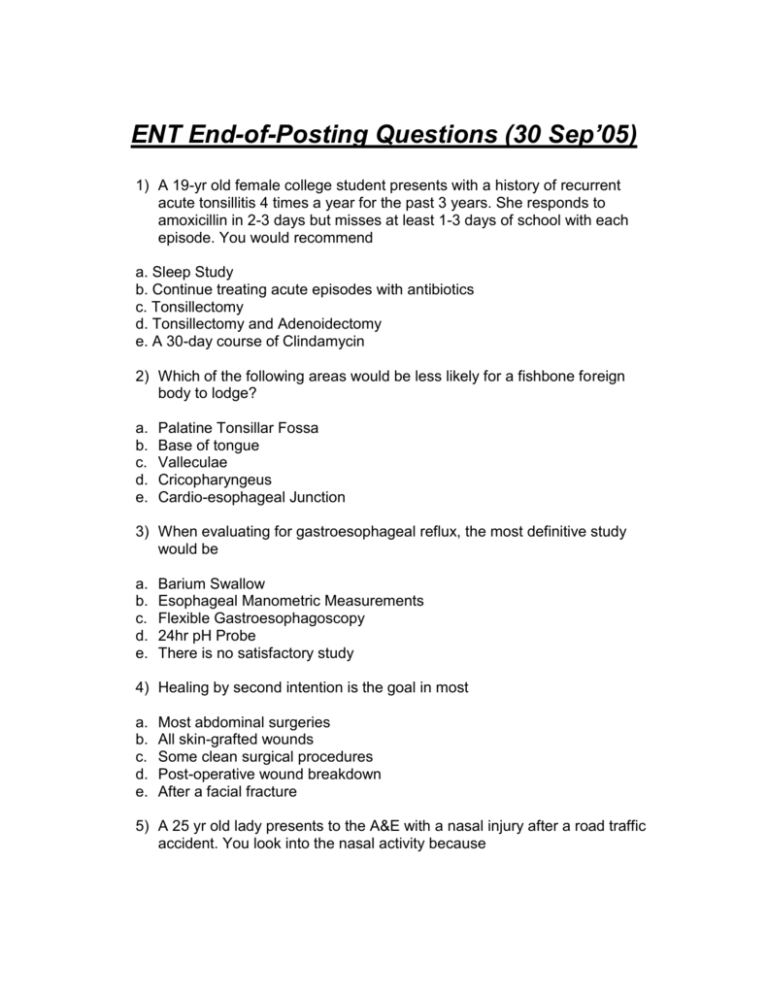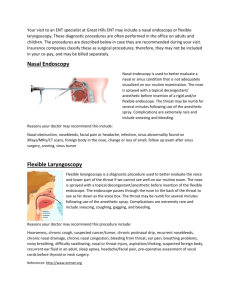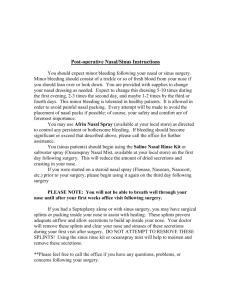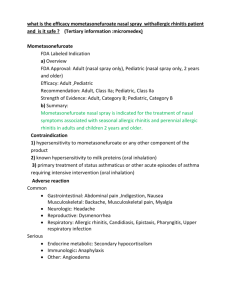ENT End of Posting Test 30 Sep 05
advertisement

ENT End-of-Posting Questions (30 Sep’05) 1) A 19-yr old female college student presents with a history of recurrent acute tonsillitis 4 times a year for the past 3 years. She responds to amoxicillin in 2-3 days but misses at least 1-3 days of school with each episode. You would recommend a. Sleep Study b. Continue treating acute episodes with antibiotics c. Tonsillectomy d. Tonsillectomy and Adenoidectomy e. A 30-day course of Clindamycin 2) Which of the following areas would be less likely for a fishbone foreign body to lodge? a. b. c. d. e. Palatine Tonsillar Fossa Base of tongue Valleculae Cricopharyngeus Cardio-esophageal Junction 3) When evaluating for gastroesophageal reflux, the most definitive study would be a. b. c. d. e. Barium Swallow Esophageal Manometric Measurements Flexible Gastroesophagoscopy 24hr pH Probe There is no satisfactory study 4) Healing by second intention is the goal in most a. b. c. d. e. Most abdominal surgeries All skin-grafted wounds Some clean surgical procedures Post-operative wound breakdown After a facial fracture 5) A 25 yr old lady presents to the A&E with a nasal injury after a road traffic accident. You look into the nasal activity because a. She might have a deviated nasal septum which you might want to correct immediately b. A septal haematoma might have developed and will require immediate drainage c. Foreign bodies from the accident site will need removal d. You want to see if your examination causes pain since that will indicate whether the nasal bones have been fractured e. You want to pack the nose with Merocel since bleeding is a potential risk after nasal trauma 6) The most common inhalant allergies in Singapore is a. b. c. d. e. Cockroach Animal Dander House Dust Mite Molds Tree Pollen 7) A 22yr old NUS student comes to your clinic complaining of a chronically blocked nose for 10 years. The only relief he can get is to use oxymetazalone or pseudoephedrine nose drops. At first he used them at night, but now he has to use them 4-5 times a day. You would suspect his diagnosis to be a. b. c. d. e. Allergic Rhinitis Non-allergic Rhinitis Eosinophilic Syndrome Rhinitis Medicamentosa Vasomotor Rhinitis Chronic Infected Rhinitis 8) Which one of the following is most unlikely to be the cause of a nasal septal perforation a. b. c. d. e. Nose-picking Septo-plasty Cocaine Sniffing Chronic Use of a Nasal Steroid Spray Working in a nickel factory 9) You are asked to see a 6 yr old girl who has a 2 year history of purulent cough, purulent nasal drainage and blocked nose. Examination confirms these features. Your first diagnosis would be a. Allergic Rhinitis b. Vasomotor Rhinitis c. Chronic Sinusitis d. Chronic Bronchitis e. GERD 10) A 73 yr old man with uncontrolled hypertension presents to the A&E with severe right-sided epistaxis. The initial treatment would likely require a. b. c. d. e. Anterior nasal pack with Merocel Anterior nasal pack with Merocel and posterior pack with Foley’s Catheter Pack nose with ….. Electrocaultery of sphenopalatine artery Refer to … for embolization of internal maxillary artery 11) Why is it important to detect hearing loss in a child as soon as possible? a. 12) An 18 yr old male complains of drainage from his left ear 3-4times per year which will last 1-2 weeks. There is no pain, but he has noted some hearing loss in the left ear. On examination, the ear canal is dry and the tympanic membrane is normal except for a small amount of cerumenepithelial debris above the short process of the malleolus. You would be concerned that there may be : a. b. c. d. e. Recurrent external otitis Perforation of the pars tensa Perforation of the pars tensa with cholesteatoma Retraction pocket in the pars flaccida with cholesteatoma Labyrinthine Fistula 13) A 36 yr old bartender presents with a 48 hour history of the sudden onset of vertigo accompanied by nausea and vomiting. There is no hearing loss. You would a. Diagnose endolymphatic hydrops ( Meniere’s Disease) b. Treat him with a low-salt diet and diuretic c. Expect no vestibular function in one ear on electronystamography one month later d. Recommend a vestibular nerve section e. Suspect a brain tumour near the Medial Longitudinal Fasciculus (MLF) 14) A 1 yr old Afro-American male is brought to your office with a history of recurrent acute otitis media every 3-4 weeks for six months. Which of the following factors would you consider a major contributor to this problem? a. Sex b. Race c. Climate in Singapore d. Possibility of sickle-cell anaemia e. Attendance at group day care while parents work 15) Which of the following is the most unlikely to produce a blue tympanic membrane? a. b. c. d. e. Glomus Jugulare Temporal bone fracture Otitis Media with Effusion Congenital Cholesteatoma Glomus Tympanicum 16) A 38 yr old male presents to the clinic with NPC. Which will be the first group of lymph nodes you would expect to be involved with metastasis? a. b. c. d. e. 2 3 4 5 Retropharyngeal nodes 17) A major characteristic of adenoid cystic carcinoma of one of the salivary glands is its propensitiy to a. b. c. d. e. Mets to regional lymph nodes Mets to lungs Invade local tissues only Invade and spread along nerves Mets to bone 18) A 50yr old male presents with a left sided nasal mass, obstructing the nose which bleeds easily when touched. There is no pain. You would recommend a. b. c. d. e. FNAC of lesion Sinus X-rays Course of Antibiotics and nasal steroid spray for 2 weeks Coronal CT scans of sinus Have patient return in 2 weeks 19) A 54 yr old male presents with a T3, N0, M0 carcinoma of the right tonsil. His risk of developing a second primary in the head and neck over the next 30 yrs is approximately a. 5% b. c. d. e. 10% 20% 40% 50% 20) A 35 yr old female presents to your clinic complaining of diplopia when looking to the left. On examination there is an ulcerated mass in the nasopharynx. You would suspect the patient has NPC which has extended to the a. b. c. d. e. Right cavernous sinus Left cavernous sinus Right Superior Orbital Fissure Left Superior Orbital Fissure Right Orbit 21) A 10 yr old boy presents with a small (1.2mm) opening at the anterior border of the SCM just level with the superior border of the thyroid cartilage. It drains intermittently. What course would the sinus tract most likely take? a. Deep to the 7th nerve and end in the external ear canal b. Run parallel to the external auditory canal c. Superior to the skin opening, between the external and internal carotid artery and enter at the base of the tonsil d. Medial to the skin tract and then anterior to the carotid artery, superficial to the superior cornu of the thyroid cartilage and enter the pyriform sinus e. Inferior into the mediastinum, around the arch of the aorta and then superior to open into the upper esophagus 22) A child presents with a small draining tract at the lower anterior border of the SCM. Where would the most likely spot for this fistula to connect internally? a. b. c. d. e. Middle Ear space Tonsillar fossa Pyriform sinus Cricopharyngeus Upper esophagus 23) A 5yr old has had a 1 week history of fever, left earache and hearing loss. His mother brought him to her GP after 2 days who prescribed a course of Amoxycillin, nasal decongestants and antipyretics. The child’s mother now claims that the child still has fever and ear pain. Examination reveals an intact but bulging and red eardrum on the left side. The rest of the ENT exam is normal. What would be the next most appropriate line of treatment? a. Continue with amoxicillin and nasal decongestants, reassuring the mother that the condition will resolve itself soon b. Change antibiotics to Augmentin and do a myringotomy c. Perform a myringotomy and a grommet tube insertion d. Continue with antibiotics and decongestants but perform a CT scan of the temporal bone to exclude complications of acute otitis media e. Take a swab from the nasal cavity since the pathogen is most likely to have been originated from there and change the antibiotic according to the sensitivity 24) With respect to obstructive sleep apnoea in a child, all the following are possible symptoms, except a. b. c. d. e. Bed-wetting Failure to thrive Disturbed sleep Snoring Fits 25) A cochlear implant is an electronic device that is surgically implanted to improve hearing in a child with a. b. c. d. e. Severe Profound Bilateral Conductive Hearing Loss Severe Profound Unilateral Sensorineural Hearing Loss Severe Profound Bilateral Sensorineural Hearing Loss Severe Profound Bilateral Hearing Loss if the child is less than 4 yrs old Bilateral Absent Cochlear Nerves





